Angel Wings, Caladium, Elephant’s Ear, are common names for the vibrant plant botanically known as Caladium. Belonging to the Araceae family, this striking plant originates from tropical regions of Central and Northern South America. Known for its bold, colorful foliage and unique patterns, Caladium is an annual that thrives in warm, humid environments.
Native to tropical climates, these plants bring a splash of color to gardens during summer, even in areas outside their natural hardiness zone. Versatile and eye-catching, Caladium is also a popular choice as a seasonal houseplant, offering an exotic touch to indoor spaces.
| Common name | Angel Wings, Caladium, Elephant’s Ear |
| Botanical name | Caladium |
| Family | Araceae |
| Origin | Central and Northern South America |
| Life cycle | Annual |
| Plant type | Annual |
| Hardiness zone | 9, 10 |
| Sunlight | Dappled Sunlight |
| Maintenance | Medium |
| Soil condition | High Organic Matter |
| Soil ph | Acid |
| Drainage | Well-Drained |
| Spacing | Less than 12 in. |
| Flowering period | Summer |
| Height | 6 in. – 2 ft. |
| Flower color | Green |
| Leaf color | Gray, Silver |
| Leaf benefit | Showy |
| Flower benefit | Showy |
| Garden style | Shade Garden |
| Uses | Container |
I. Appearance and Characteristics
Caladium is a genus of flowering plants in the family Araceae. They are often known by the common name elephant ear (which they share with the closely related genera Alocasia, Colocasia, and Xanthosoma), heart of Jesus, and angel wings. There are over 1000 named cultivars of Caladium bicolor from the original South American plant.
The genus Caladium includes seven species that are native to South America and Central America, and naturalized in India, parts of Africa, and various tropical islands. They grow in open areas of the forest and on the banks of rivers and go dormant during the dry season.
The wild plants grow to 15–35 inches (40–90 cm) tall, with leaves mostly 6-18 inches (15–45 cm) long and broad.
From Malay Keladi, which refers to a few genera within the Araceae family (Alocasia, Caladium and Dieffenbachia). However, it may just specifically refer to the Colocasia genus.
Caladiums grow from tubers and can be propagated by dividing the tubers. They are hardy only to USDA plant hardiness zone 10; in colder areas, they are typically grown as tender “bulbs” or as houseplants.
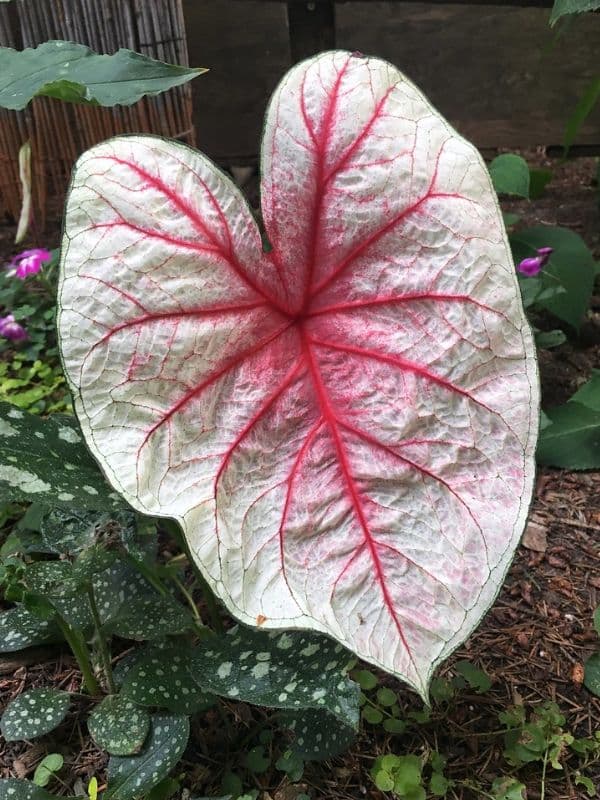
During their growing season, they require moderate watering (damp, not soggy). Most varieties prefer partial to full shade, although sun-resistant varieties are now in cultivation. Approximately 98% of all caladium “bulbs” are from Lake Placid, Florida, in the United States. In recent years, many new varieties have become available through breeding and are now largely disease resistant.
The bulk of “bulb” production is sold to pot producers, who in turn provide local nursery outlets with potted caladiums ready for immediate planting. Most “bulb” growers also sell direct retail via websites, shipping of “bulbs” takes place in the spring when temperatures permit (“bulbs” are subject to damage if temperatures are too low).
In temperate areas, they should be lifted before the first frost. The tubers are dried and stored for the winter when temperatures fall to 65 °F (18 °C), and stored moderately dry (not bone-dry) over the winter at temperatures between 56 °F (13 °C) and 61 °F (16 °C).
All parts of the plant are poisonous. They should not be ingested and may irritate sensitive skin.
II. How to Grow and Care
Sunlight
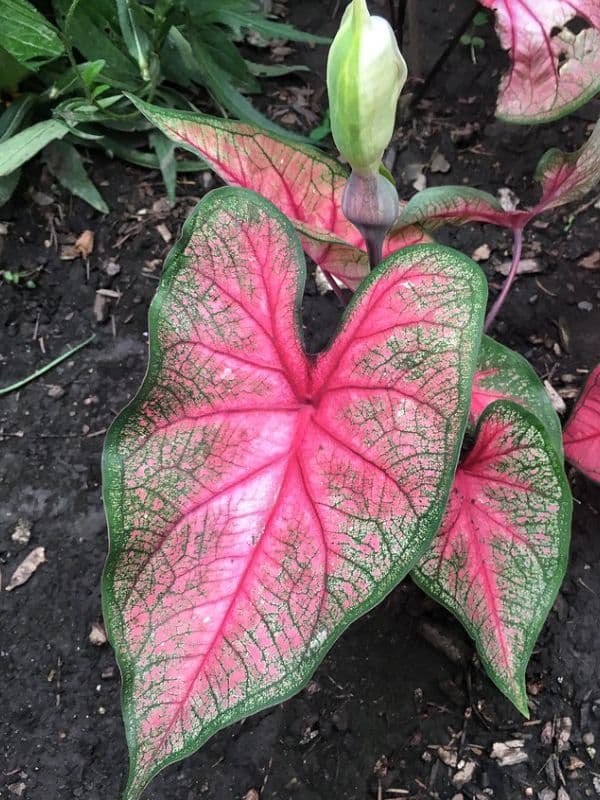
Caladium plants prefer indirect light or moderate shade indoors. The narrower the leaves, the greater the amount of sun they can withstand. Growing them outdoors in containers gives you more control over light conditions. Some newer cultivars can be grown in full sun, but most caladiums need protection from too much intense light. When growing them in a garden, give them partial shade to full shade; full sun scorches their leaves.
Temperature and Humidity
The warmer the better for caladium houseplants. Aim for 70-75 degrees Fahrenheit during the day, 60-65 degrees at night, if possible, as that is the temperature at which tubers begin to grow. Keep the humidity as high as is practical.
When planting outdoors, you can transplant potted tubers (or, better yet, simply transfer them in peat pots) after the last frost date for your area. Plants grown this way should be started indoors four to six weeks prior to transplanting.
Watering
When leaves appear on the plant, water as needed to keep the soil evenly moist. Never let the plant dry out, as leaves may yellow and drop. Stop watering the plant when the leaves start to die back. Resume watering in spring after winter dormancy. New leaves will reappear as temperatures warm.
Soil
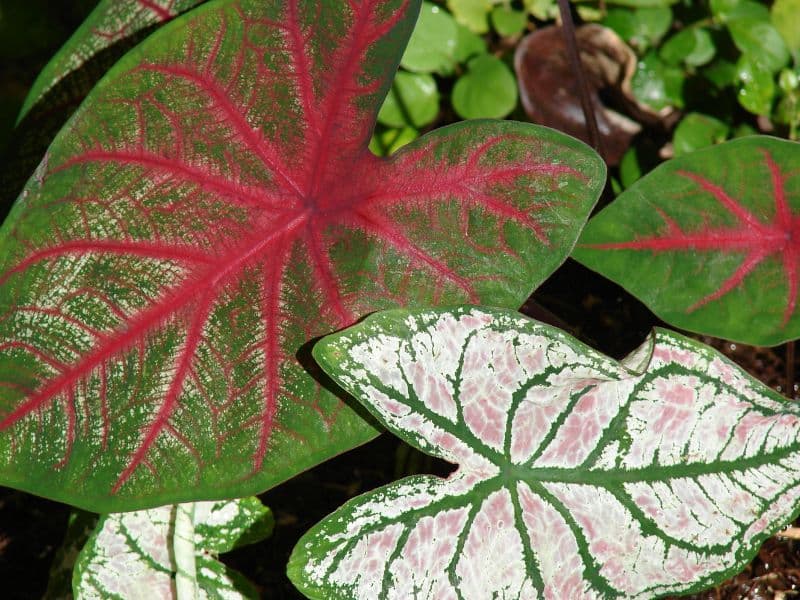
Though caladium plants appreciate consistent moisture, their soil should drain well. Caladiums will not tolerate soil that’s oversaturated or otherwise waterlogged. Most potting mixes are sufficient for growing caladium in containers. However, soil mediums specifically designed for use with acid-loving plants are also a good option.
Fertilizing
Though caladium plants are not considered heavy feeders, they do benefit from the use of a balanced, slow-release feed at planting time. Caladiums in pots require fertilizer more frequently. Monthly applications of a water-soluble feed are ideal to encourage the production of new leaves.
Pruning
If you’re growing caladiums indoors, you’ll need to prune them regularly. Remove dead or damaged leaves as they appear, helping to keep pots tidy and prevent disease. Clip back the plant’s flowers as they appear, since allowing the plant to bloom can decrease its ornamental value. As caladium plants approach dormancy, their foliage will begin to die back. At this time, the entire plant can be cut back to soil level.
Propagation
When the plants die back in the fall or early winter, you can save the tubers in a bag and replant them next year for another show. Tubers of mature caladium can also be divided using the following steps:
- Allow the leaves to die back in the fall. Let the soil dry out a bit, then lift the tubers from the ground. Store in a box in a cool, dry, dark place, like a basement, with temperatures at about 55 degrees Fahrenheit.
- In late winter/early spring, use a sharp, sterile cutting tool to cut tubers. Make sure that each new tuber section has at least one growing site (with an eye or a knob).
- Allow the tubers to “heal” for a week, developing a callus on the cut ends.
- Plant the tubers with the “eye” facing up outdoors or in pots again when the next growing season begins and soil temperatures are over 70 degrees Fahrenheit.
Repotting
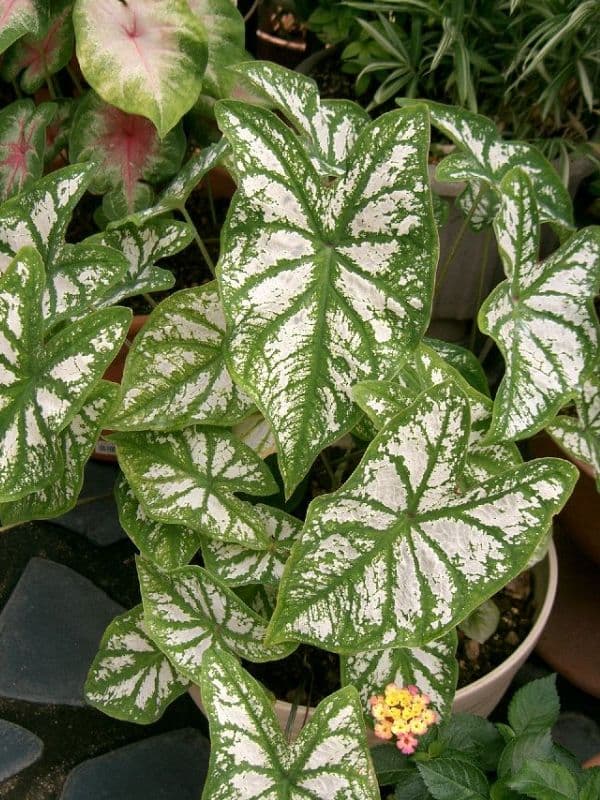
After dividing the tubers, allow each segment to dry before planting them. During this time, the cut section will form a callus which helps protect the new plant against rot and other diseases. Tuber sections can then be planted into individual pots. After a thorough watering, move containers to a warm location where they are able to receive bright, indirect light.
Overwintering
In the Tropical South, you can leave tubers in the ground year-round. In the rest of the South, you’ll need to dig them up in early fall if you want to replant next year. Save the larger tubers, which tend to produce more leaves. Remove any remaining leaves and roots. Let tubers dry in a shaded area for a few days. Place them in dry peat moss to store, and keep them in a warm spot (at least 50°F) until it’s time to replant.
Pests and Diseases
Common Pests & Plant Diseases
Caladiums are relatively pest- and disease-free but susceptible to caterpillars, aphids, and slugs. Maintaining a healthy soil, sun, and watering balance will help prevent infestations. If you notice marks or holes in the foliage, treat them with insecticidal soap. This treatment should also help avoid mealybugs, mites, thrips, and whiteflies. If only a few pests are present, try removing them by hand.
Some diseases that impact caladiums include fungal pathogens that infect the tubers, such as Rhizoctonia and Pythium species. These fungal infections infect the soil and destroy the tuber. Avoid these problems by planting in warm soil and not overwatering.
Common Problems
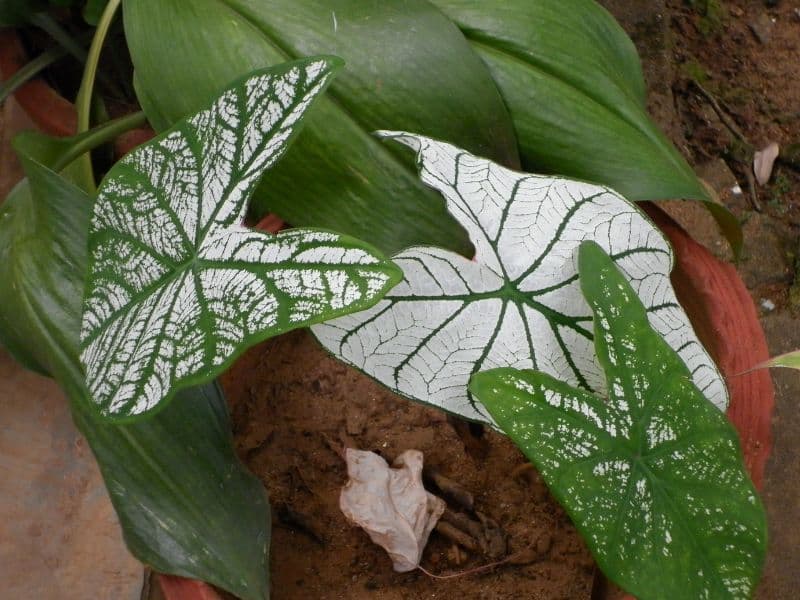
Caladiums generally have few problems, but they aren’t immune to them. If you notice yellow or brown leaves, that may be cause for concern. Some issues may be caused by improper care, which can often be easily improved.
Drooping Leaves
Occasionally, caladium leaves and stems will bend before dormancy. This is entirely normal if visible on only a few leaves. If all the leaves start to drop, it can signify that the soil is either too dry or wet. Soil that’s too dry deprives the plant of nutrients, while the caladium is susceptible to root rot if it is too wet.
Leaves Turning Yellow
There are many reasons why caladium leaves turn yellow. Any change in its regular care routine (water, light exposure, temperature) can cause yellowing. Improperly managed soil can also lead to nutrient deficiency, resulting in yellowing leaves. Depending on the time of the year, caladiums might be experiencing dormancy.
Leaves Turning Brown
Like yellow leaves, an imbalance in care causes caladium leaves to turn brown. This change in leaf color means the soil is too dry, too much sunlight is burning the leaves, the environment is not humid enough, or it is over-fertilized.
III. Types of Caladium
There are literally too many cultivars to keep track of—caladium cultivars are green, red, pink, white, even orange. In many cases, cultivars are sold without names. Almost all cultivars are descended from C. bicolor, which is native to South America. Some books list these plants as C. hortulanum. Choose your variety based on its appearance. They will make a showy border or a single plant.
A few noteworthy cultivars include:
- Caladium ‘Creamsicle’: This variety can be a vigorous grower. It features large green leaves accented with vibrant red and veined with bright white.
- Caladium ‘White Christmas’: Large, arrow-shaped green leaves with a heavy “dusting” of bright white make a simple and striking color combination in this variety.
- Caladium ‘Miss Muffet’: This dwarf variety reaches only about 8 inches in height and has lime-green leaves flecked with bright pink spots.
- Caladium ‘Puppy Love’: This relative newcomer has pink leaves edged in green and can tolerate full sun in some climates.
Find Where to Buy the Best Elephant’s Ear Plant (Caladium)

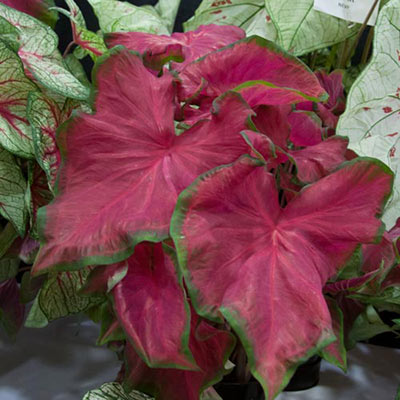
















Leave a Reply